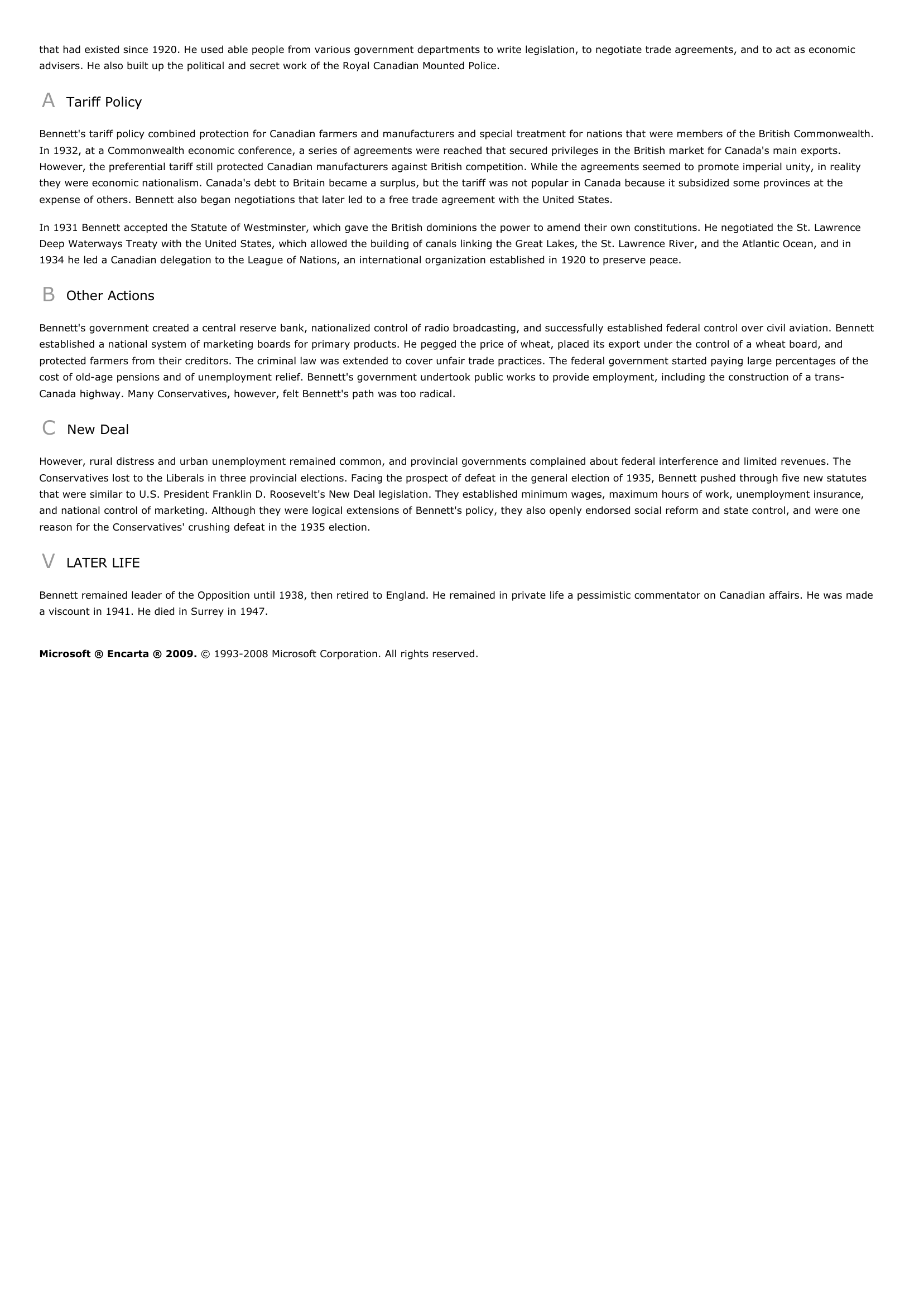Richard Bennett.
Publié le 10/05/2013

Extrait du document
«
that had existed since 1920.
He used able people from various government departments to write legislation, to negotiate trade agreements, and to act as economicadvisers.
He also built up the political and secret work of the Royal Canadian Mounted Police.
A Tariff Policy
Bennett's tariff policy combined protection for Canadian farmers and manufacturers and special treatment for nations that were members of the British Commonwealth.In 1932, at a Commonwealth economic conference, a series of agreements were reached that secured privileges in the British market for Canada's main exports.However, the preferential tariff still protected Canadian manufacturers against British competition.
While the agreements seemed to promote imperial unity, in realitythey were economic nationalism.
Canada's debt to Britain became a surplus, but the tariff was not popular in Canada because it subsidized some provinces at theexpense of others.
Bennett also began negotiations that later led to a free trade agreement with the United States.
In 1931 Bennett accepted the Statute of Westminster, which gave the British dominions the power to amend their own constitutions.
He negotiated the St.
LawrenceDeep Waterways Treaty with the United States, which allowed the building of canals linking the Great Lakes, the St.
Lawrence River, and the Atlantic Ocean, and in1934 he led a Canadian delegation to the League of Nations, an international organization established in 1920 to preserve peace.
B Other Actions
Bennett's government created a central reserve bank, nationalized control of radio broadcasting, and successfully established federal control over civil aviation.
Bennettestablished a national system of marketing boards for primary products.
He pegged the price of wheat, placed its export under the control of a wheat board, andprotected farmers from their creditors.
The criminal law was extended to cover unfair trade practices.
The federal government started paying large percentages of thecost of old-age pensions and of unemployment relief.
Bennett's government undertook public works to provide employment, including the construction of a trans-Canada highway.
Many Conservatives, however, felt Bennett's path was too radical.
C New Deal
However, rural distress and urban unemployment remained common, and provincial governments complained about federal interference and limited revenues.
TheConservatives lost to the Liberals in three provincial elections.
Facing the prospect of defeat in the general election of 1935, Bennett pushed through five new statutesthat were similar to U.S.
President Franklin D.
Roosevelt's New Deal legislation.
They established minimum wages, maximum hours of work, unemployment insurance,and national control of marketing.
Although they were logical extensions of Bennett's policy, they also openly endorsed social reform and state control, and were onereason for the Conservatives' crushing defeat in the 1935 election.
V LATER LIFE
Bennett remained leader of the Opposition until 1938, then retired to England.
He remained in private life a pessimistic commentator on Canadian affairs.
He was madea viscount in 1941.
He died in Surrey in 1947.
Microsoft ® Encarta ® 2009. © 1993-2008 Microsoft Corporation.
All rights reserved..
»
↓↓↓ APERÇU DU DOCUMENT ↓↓↓
Liens utiles
- Richard Bedford Bennett - biography.
- Richard Bennett - Canadian History.
- Bennett, Richard Bedford
- Compte-rendu critique 5 « La transformation des modèles d’organisation et de démocratie dans les partis. L’émergence du parti-cartel », Richard Katz
- En quoi Richard Wagner, l’homme et ses œuvres musicales, sont-elles non seulement un outil de propagande, mais également une esthétisation de la politique et de l’idéologie nazie ?

































